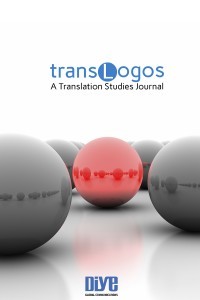From the ‘Real’ Author to the ‘Real’ Reader: Manipulation in Translation
From the ‘Real’ Author to the ‘Real’ Reader: Manipulation in Translation
The aim of this article is to examine an edition of Mustafa Kemal Atatürk’s Nutuk (The great speech) from the perspective of translation studies. The research subject is Mustafa Kemal Atatürk’ün Anlatımıyla Çocuklar için Nutuk (The great speech for children with Mustafa Kemal Atatürk’s narration), intralingually translated by Hakan Atalay (2018). This edition has been selected for examination among many others, because on the copyright page of the edition Atalay has been presented as the ‘author’ of the book and children as its target reader on the cover. In the present article, both claims will be questioned from the perspective of translation studies with an interdisciplinary approach where the narratological framework will be used in the analysis of the book which I consider not only as an example of intralingual translation but also a translation between genres. For this purpose, the present article will take O’Sullivan’s (2003) article as its reference point in which the scholar elaborates the narrative diagram put forward by Chatman (1978) by adding a translational dimension to it. Based on the analysis, the article will conclude with some questions about manipulation in translation with the hope that they will lead the way to new discussions in translation studies.
___
- Atalay, Hakan, ed. 2018. Çocuklar için Nutuk [The great speech for children]. By Mustafa Kemal Atatürk. Istanbul: İskenderiye.
- Atatürk, Mustafa Kemal. 1927. Nutuk [The great speech]. Ankara: Türk Teyyare Cemiyeti.
- Atatürk, Mustafa Kemal. 1934. Nutuk [The great speech]. Istanbul: Devlet Matbaası.
- Atatürk, Mustafa Kemal. 2008. The Great Speech. Ankara: Atatürk Research Center.
- Balpınar, Özgür, ed. 2019. Çocuklar için Nutuk. [The great speech for children]. By Mustafa Kemal Atatürk. Istanbul: Lades Kitap.
- Berk Albachten, Özlem. 2013. “Intralingual Translation as ‘Modernization’ of the Language: the Turkish Case.” Perspectives 21 (2): 257-271. doi: 10.1080/0907676X.2012.702395.
- Berktay, Ali, ed. 2016. Gençler için Fotoğraflarla Nutuk [The great speech with photographs for the youth]. By Mustafa Kemal Atatürk. Istanbul: Türkiye İş Bankası Kültür Yayınları.
- Bilici, Ali Rüştü, ed. 2017. Mustafa Kemal Atatürk’ten Gençliğe: Çocuklar için Nutuk [from Mustafa Kemal Atatürk to the youth: the great speech for children]. By Mustafa Kemal Atatürk. Istanbul: Elhamra.
- Chatman, Seymour. 1978. Story and Discourse: Narrative Structure in Fiction and Film. Ithaca: Cornell University Press.
- Chatman, Seymour. 1990. Coming to Terms: The Rhetoric of Narrative in Fiction and Film. Ithaca: Cornell University Press.
- Demirel, Yücel, ed. 2018. Günümüz Türkçesiyle Nutuk [The great speech in today’s Turkish]. By Mustafa Kemal Atatürk. Istanbul: Yapı Kredi.
- Doğan, Erdal, ed. 2017. Nutuk: İlköğretim Okulları için [The great speech: for the elementary school students]. By Mustafa Kemal Atatürk. Istanbul: Say.
- Hermans, Theo, ed. 1985. The Manipulation of Literature: Studies in Literary Translation. London: Croom Helm.
- Jakobson, Roman. (1959) 2000. “On Linguistic Aspects of Translation.” In The Translation Studies Reader, edited by Lawrence Venuti, 113-8. London: Routledge.
- Kalecikli, Kenan, ed. 2017. İlköğretim Öğrencileri için Nutuk (Söylev) [The great speech (the great discourse) for the elementary school students]. By Mustafa Kemal Atatürk. Ankara: Delta Kültür.
- Korhan, Kaan Kemal, ed. 2018. Cumhuriyetimizin Emanetçisi Olan Çocuklarımız için Nutuk [The great speech for children who are the guardians of our republic]. By Mustafa Kemal Atatürk. Ankara: Kripto Kitaplar.
- Lefevere, André. 1992. Translation, Rewriting, and the Manipulation of Literary Fame. London: Routledge.
- O’Sullivan, Emer. 2003. “Narratology Meets Translation Studies; or, The Voice of the Translator in Children’s Literature.” Meta 48 (1-2): 197-207. doi: 10.7202/006967ar.
- Paker, Saliha. 2014. “Terceme, Te’lîf ve Özgünlük Meselesi.” In Eski Türk Edebiyatı Çalışmaları — IX Metnin Hâlleri: Osmanlı’da Telif, Tercüme ve Şerh, edited by Hatice Aynur, Müjgân Çakır, Hanife Koncu, Selim S. Kuru, and Ali Emre Özyıldırım, 36-71. İstanbul: Klasik.
- Schiavi, Giuliana. 1996. “There is Always a Teller in a Tale.” Target 8 (1): 1-21. doi: 10.1075/target.8.1.02sch.
- Velidedeoğlu, Hıfzı Veldet, ed. 1998. Söylev [The great discourse]. 2 vols. Istanbul: Çağdaş.
- Yayın Aralığı: Yılda 2 Sayı
- Başlangıç: 2018
- Yayıncı: Diye Yayınları
